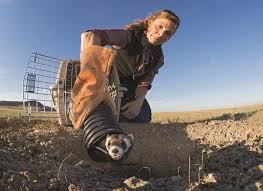In 2013, Colorado Parks and Wildlife set out on a mission to bring back the Black-footed Ferret. Now, the project is turning into a major success story.
A year after 28 ferrets were released at the Rocky Mountain Arsenal National Wildlife Refuge, 20 still remain - a staggering 71 percent. Kimberly Fraser, a specialist from the federal ferret program, describes the survival rate as “phenomenal”.
 In addition to the 20 original captive-born ferrets that were released, researchers reported finding 27 ferrets who have been born at the refuge since 2015. The population is an amazing discovery according to refuge manager David Lucas, who says the number is “higher than…expected”.
Black-footed ferrets were declared extinct in 1979 when their native habitat was encroached on by city development, and their main food source - prairie dogs - suffered a major population drop due to sickness and extermination.
In addition to the 20 original captive-born ferrets that were released, researchers reported finding 27 ferrets who have been born at the refuge since 2015. The population is an amazing discovery according to refuge manager David Lucas, who says the number is “higher than…expected”.
Black-footed ferrets were declared extinct in 1979 when their native habitat was encroached on by city development, and their main food source - prairie dogs - suffered a major population drop due to sickness and extermination.
[caption id="attachment_5995" align="alignnone" width="409"]

Prairie Wildlife Research[/caption]
But in 1981, the discovery of a Black-footed ferret colony in Meeteetse, Wyoming prompted the U.S. Fish and Wildlife Service to create a reintroduction program for the weasels. Since then, ferrets have been released in eight states across the U.S., and officials now estimate 300 ferrets live in the wild.
[caption id="attachment_5999" align="alignnone" width="263"]

Clay Bolt/World Wildlife Fund[/caption]
Colorado Parks and Wildlife joined the initiative in 2013 and has released a combined 300 ferrets at six different sites across the state. According to biologists, all six sites have maintained a ferret population, an optimistic outlook for the still-endangered species.
 In addition to the 20 original captive-born ferrets that were released, researchers reported finding 27 ferrets who have been born at the refuge since 2015. The population is an amazing discovery according to refuge manager David Lucas, who says the number is “higher than…expected”.
Black-footed ferrets were declared extinct in 1979 when their native habitat was encroached on by city development, and their main food source - prairie dogs - suffered a major population drop due to sickness and extermination.
[caption id="attachment_5995" align="alignnone" width="409"]
In addition to the 20 original captive-born ferrets that were released, researchers reported finding 27 ferrets who have been born at the refuge since 2015. The population is an amazing discovery according to refuge manager David Lucas, who says the number is “higher than…expected”.
Black-footed ferrets were declared extinct in 1979 when their native habitat was encroached on by city development, and their main food source - prairie dogs - suffered a major population drop due to sickness and extermination.
[caption id="attachment_5995" align="alignnone" width="409"] Prairie Wildlife Research[/caption]
But in 1981, the discovery of a Black-footed ferret colony in Meeteetse, Wyoming prompted the U.S. Fish and Wildlife Service to create a reintroduction program for the weasels. Since then, ferrets have been released in eight states across the U.S., and officials now estimate 300 ferrets live in the wild.
[caption id="attachment_5999" align="alignnone" width="263"]
Prairie Wildlife Research[/caption]
But in 1981, the discovery of a Black-footed ferret colony in Meeteetse, Wyoming prompted the U.S. Fish and Wildlife Service to create a reintroduction program for the weasels. Since then, ferrets have been released in eight states across the U.S., and officials now estimate 300 ferrets live in the wild.
[caption id="attachment_5999" align="alignnone" width="263"] Clay Bolt/World Wildlife Fund[/caption]
Colorado Parks and Wildlife joined the initiative in 2013 and has released a combined 300 ferrets at six different sites across the state. According to biologists, all six sites have maintained a ferret population, an optimistic outlook for the still-endangered species.
Clay Bolt/World Wildlife Fund[/caption]
Colorado Parks and Wildlife joined the initiative in 2013 and has released a combined 300 ferrets at six different sites across the state. According to biologists, all six sites have maintained a ferret population, an optimistic outlook for the still-endangered species.
